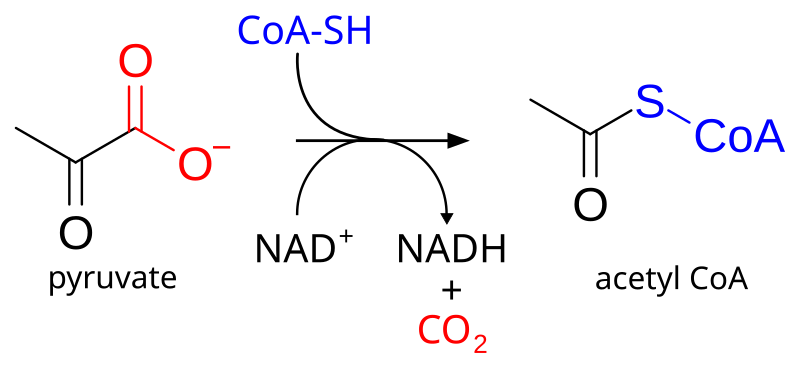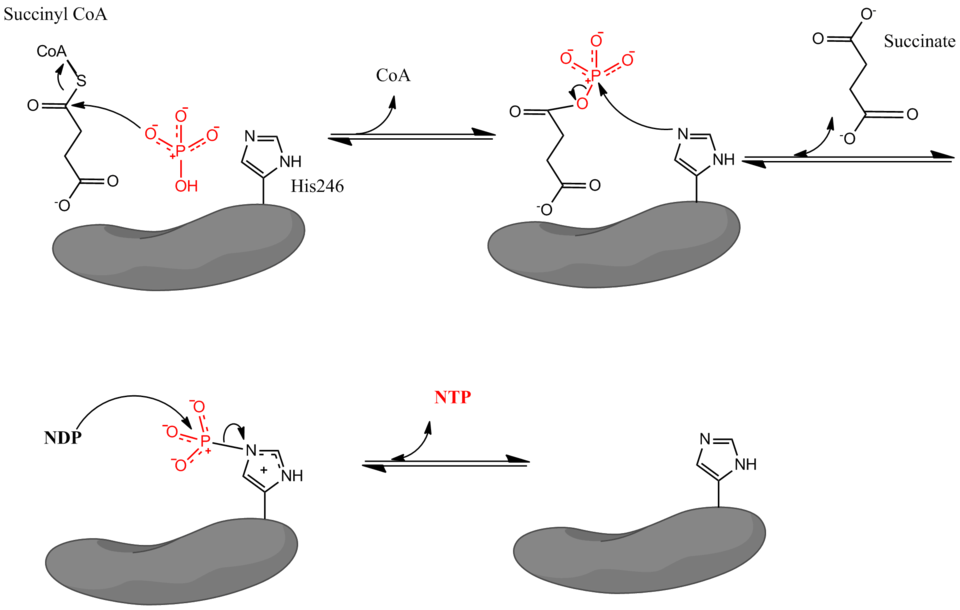OCR Specification focus:
‘Describe pyruvate decarboxylation to acetyl CoA; Krebs cycle formation of citrate and reconversion to oxaloacetate; decarboxylation, dehydrogenation, reduced NAD and FAD, and substrate-level phosphorylation.’
The link reaction and Krebs cycle are key stages of aerobic respiration, transforming pyruvate into reduced coenzymes and ATP through a series of enzyme-controlled steps within the mitochondrial matrix.
The Link Reaction
Overview
The link reaction connects glycolysis (in the cytoplasm) to the Krebs cycle (in the mitochondrial matrix). It converts pyruvate, a three-carbon molecule from glycolysis, into acetyl coenzyme A (acetyl CoA), a two-carbon compound that enters the Krebs cycle.

Diagram of the pyruvate dehydrogenase complex converting pyruvate to acetyl-CoA, with CO₂ release and NADH formation. This captures oxidative decarboxylation and links glycolysis to the Krebs cycle. Labels match OCR terminology for the link reaction. Source.
Step-by-Step Process
Pyruvate transport:
Pyruvate molecules produced in glycolysis move into the mitochondrial matrix by active transport through specific carrier proteins on the inner mitochondrial membrane.Decarboxylation:
Each pyruvate molecule loses a carbon atom in the form of carbon dioxide (CO₂). This step is catalysed by the enzyme pyruvate dehydrogenase complex.Dehydrogenation:
The remaining two-carbon fragment is oxidised, transferring hydrogen atoms to NAD⁺, forming reduced NAD (NADH).Formation of acetyl CoA:
The oxidised two-carbon molecule, known as an acetyl group, combines with coenzyme A to form acetyl CoA.
The products of the link reaction (for one glucose molecule, hence two pyruvate molecules) are:
2 acetyl CoA
2 CO₂
2 reduced NAD
These molecules feed into subsequent stages: acetyl CoA enters the Krebs cycle, while reduced NAD carries hydrogen and electrons to the electron transport chain for oxidative phosphorylation.
Coenzyme A: A coenzyme that binds with an acetyl group to form acetyl CoA, enabling the acetyl group to enter the Krebs cycle.
The link reaction is sometimes called the oxidative decarboxylation of pyruvate. It does not directly produce ATP but generates essential intermediates for later ATP synthesis.
The Krebs Cycle
Location and Purpose
The Krebs cycle (or citric acid cycle) occurs in the mitochondrial matrix and is a cyclic series of redox and substrate-level phosphorylation reactions. Its main purpose is to:
Oxidise acetyl groups to CO₂
Generate reduced coenzymes (NADH and FADH₂) for oxidative phosphorylation
Produce a small amount of ATP directly
Stages of the Cycle
Each turn of the cycle processes one acetyl CoA molecule. Since one glucose molecule produces two acetyl CoA, the cycle runs twice per glucose.
Formation of citrate:
Acetyl CoA (2C) combines with oxaloacetate (4C) to form citrate (6C).
Coenzyme A is released to participate again in another link reaction.
Conversion of citrate to α-ketoglutarate (5C):
Citrate undergoes decarboxylation (releasing CO₂) and dehydrogenation (forming reduced NAD).
The resulting molecule is α-ketoglutarate.
Conversion of α-ketoglutarate to succinyl CoA (4C):
Further decarboxylation releases another CO₂ molecule.
Hydrogen removal reduces another NAD molecule to NADH.
The product succinyl CoA is formed.
Substrate-level phosphorylation:
Succinyl CoA is converted to succinate (4C).
This conversion directly phosphorylates ADP (or GDP) to form ATP (or GTP).

Mechanism of succinyl-CoA synthetase showing formation of succinyl phosphate, a phosphohistidine intermediate, and phosphate transfer to ADP/GDP to produce ATP/GTP. This visualises substrate-level phosphorylation within the Krebs cycle. Note: the phosphohistidine detail exceeds OCR A-level requirements but remains faithful to the chemistry. Source.
Regeneration of oxaloacetate:
Succinate is converted to fumarate, then malate, and finally back to oxaloacetate.
During these steps:
FAD is reduced to FADH₂.
NAD is reduced to NADH.
The regenerated oxaloacetate is ready to react with another acetyl CoA, continuing the cycle.
Summary of Products (per glucose molecule)
Because one glucose produces two acetyl CoA, the total yield from the Krebs cycle (two turns) is:
4 CO₂ (released as waste gas)
6 reduced NAD (NADH)
2 reduced FAD (FADH₂)
2 ATP (via substrate-level phosphorylation)
Key Concepts
Decarboxylation: The removal of a carbon atom from a molecule as carbon dioxide (CO₂).
After decarboxylation steps, dehydrogenation ensures that hydrogen atoms are passed to electron carriers, maintaining redox balance.
Dehydrogenation: The removal of hydrogen atoms from a substrate molecule, transferring them to NAD or FAD.
Between these processes, the Krebs cycle acts as the cell’s metabolic hub, linking carbohydrate, lipid, and amino acid metabolism.
Reduced Coenzymes and Their Roles
NAD and FAD are essential coenzymes acting as hydrogen carriers. They transport electrons and protons from the Krebs cycle to the electron transport chain on the inner mitochondrial membrane, where oxidative phosphorylation occurs.
NAD accepts hydrogen during several stages of the Krebs cycle (at isocitrate, α-ketoglutarate, and malate conversions).
FAD accepts hydrogen from succinate, forming FADH₂.
These reduced coenzymes donate electrons to the electron transport chain in later stages, driving ATP synthesis.
Reduced NAD (NADH): A coenzyme that carries high-energy electrons and hydrogen ions to the electron transport chain for ATP production.
Substrate-Level Phosphorylation
Substrate-level phosphorylation is the direct synthesis of ATP from ADP using energy released from the transfer of a phosphate group from a substrate molecule. In the Krebs cycle, this occurs when succinyl CoA is converted to succinate.
EQUATION
—-----------------------------------------------------------------
Substrate-level phosphorylation (ATP production) = ADP + Pi → ATP
ADP = Adenosine diphosphate, energy carrier molecule
Pi = Inorganic phosphate group
ATP = Adenosine triphosphate, main cellular energy currency
—-----------------------------------------------------------------
This ATP is immediately available for cellular activities, unlike ATP produced via oxidative phosphorylation, which requires electron transport processes.
Carbon and Energy Flow
The carbon atoms from glucose are completely oxidised during the Krebs cycle, leaving as CO₂. Meanwhile, energy from the oxidation of acetyl groups is conserved in NADH, FADH₂, and ATP. These coenzymes subsequently fuel the final stage of aerobic respiration — oxidative phosphorylation — linking the Krebs cycle to efficient energy generation.
FAQ
Coenzyme A acts as a carrier molecule that binds to the two-carbon acetyl group produced from pyruvate during the link reaction, forming acetyl CoA.
This compound delivers the acetyl group into the Krebs cycle, where it reacts with oxaloacetate to form citrate. Coenzyme A itself is then released and reused.
Without coenzyme A, the transfer of carbon atoms from glycolysis into the Krebs cycle could not occur efficiently, halting aerobic respiration.
The Krebs cycle depends on the continual recycling of oxidised NAD⁺ and FAD.
Under aerobic conditions, oxygen acts as the final electron acceptor in the electron transport chain, allowing reduced coenzymes (NADH and FADH₂) to be reoxidised.
If oxygen is absent, NADH and FADH₂ cannot release their electrons, causing these carriers to accumulate in their reduced form, halting both the link reaction and the Krebs cycle.
The oxidation of acetyl groups releases energy, which is conserved in three key ways:
Reduction of NAD⁺ to NADH and FAD to FADH₂, storing energy in chemical form for use in oxidative phosphorylation.
Formation of ATP (or GTP) through substrate-level phosphorylation.
The remaining energy is released as heat, maintaining body temperature in endothermic organisms.
These mechanisms ensure maximum ATP yield from each glucose molecule.
Several enzymes act as control points to regulate the cycle’s rate and ensure efficiency:
Citrate synthase: Regulated by ATP and NADH concentrations; inhibited when energy levels are high.
Isocitrate dehydrogenase: Activated by ADP and inhibited by NADH; this enzyme controls the rate of NADH production.
α-Ketoglutarate dehydrogenase: Inhibited by its products (succinyl CoA and NADH).
This regulation ensures the cycle matches the cell’s current energy demands.
The Krebs cycle is amphibolic, meaning it participates in both energy production and biosynthesis.
Intermediates serve as building blocks for:
Amino acids (from α-ketoglutarate and oxaloacetate).
Fatty acids and cholesterol (from citrate, which can leave the mitochondrion).
Porphyrins and haem (from succinyl CoA).
Thus, the cycle supports both catabolic and anabolic processes essential for cell function.
Practice Questions
Question 1 (2 marks)
During the link reaction in aerobic respiration, pyruvate is converted into acetyl coenzyme A.
Describe the main steps that occur in this conversion.
Mark Scheme:
1 mark for stating that pyruvate is decarboxylated, releasing carbon dioxide (CO₂).
1 mark for stating that pyruvate is oxidised and hydrogen is transferred to NAD⁺, forming reduced NAD (NADH), and the resulting acetyl group combines with coenzyme A to form acetyl CoA.
Question 2 (5 marks)
Describe and explain the main stages of the Krebs cycle, including the roles of decarboxylation, dehydrogenation, and substrate-level phosphorylation.
Mark Scheme:
1 mark for stating that acetyl CoA (2C) combines with oxaloacetate (4C) to form citrate (6C).
1 mark for mentioning decarboxylation steps that release two molecules of CO₂ per cycle.
1 mark for describing dehydrogenation, with NAD⁺ and FAD being reduced to NADH and FADH₂.
1 mark for stating that ATP (or GTP) is produced directly through substrate-level phosphorylation when succinyl CoA is converted to succinate.
1 mark for explaining that oxaloacetate is regenerated, allowing the cycle to continue.

